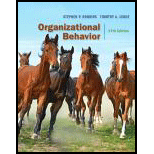
Concept explainers
To determine:
The functions and process of communication
Introduction:
Communication: The transfer and understanding of meaning
Explanation of Solution
Firstly, communication acts to manage employee behavior. When employees follow organizational policies, or their job description, they are essentially being managed by the firm’s communication. This is formal communication. Informal communication, in the way that co-workers treat employees, also aids in managing employee behavior. Secondly, communication also provides feedback to employees on their behavior. This is communicated through feedback on progress, reward for desired behavior etc. which all provides feedback to the employee on whether their behavior and performance is good or bad. Thirdly, communication also allows people to share their emotional feelings, and thereby forge relationships with co-workers. It also allows employees to fulfill their social needs, and cope with their problems by forming a social support system. Fourthly, communication acts as a tool of persuasion. This can either be good or harmful for the organization, depending on the intent of the persuader. Lastly, communication allows information exchange to facilitate decision-making. This is because communication allows information and data to be passed to others and then processed and evaluated to make a decision.
The process of communication consists of eight main stages. Firstly, the sender must initiate the message into a physical form by encoding his/her thought. This message is then transported through a channel. The channel must be chosen by the sender, and can be either formal or informal. Formal channels are established by the firm itself, and are used for communication that relates to the professional, work-related activities of the members. Informal channels are usually used to communicate personal or social messages. The message is then sent through the channel to the intended receiver. Once it is received, the recipient must decode The message into an understandable form. Noise is a part of the process that represents barriers to communication that distorts the clarity of the message. This may be because of cultural differences, information overload, perceptual problems etc. The final link in the communication process is feedback. This allows the sender to understand whether or not the message has been understood by the recipient as intended and whether it has fulfilled its purpose.
Want to see more full solutions like this?
Chapter 11 Solutions
Organizational Behavior (17th Edition) - Standalone book
 Understanding BusinessManagementISBN:9781259929434Author:William NickelsPublisher:McGraw-Hill Education
Understanding BusinessManagementISBN:9781259929434Author:William NickelsPublisher:McGraw-Hill Education Management (14th Edition)ManagementISBN:9780134527604Author:Stephen P. Robbins, Mary A. CoulterPublisher:PEARSON
Management (14th Edition)ManagementISBN:9780134527604Author:Stephen P. Robbins, Mary A. CoulterPublisher:PEARSON Spreadsheet Modeling & Decision Analysis: A Pract...ManagementISBN:9781305947412Author:Cliff RagsdalePublisher:Cengage Learning
Spreadsheet Modeling & Decision Analysis: A Pract...ManagementISBN:9781305947412Author:Cliff RagsdalePublisher:Cengage Learning Management Information Systems: Managing The Digi...ManagementISBN:9780135191798Author:Kenneth C. Laudon, Jane P. LaudonPublisher:PEARSON
Management Information Systems: Managing The Digi...ManagementISBN:9780135191798Author:Kenneth C. Laudon, Jane P. LaudonPublisher:PEARSON Business Essentials (12th Edition) (What's New in...ManagementISBN:9780134728391Author:Ronald J. Ebert, Ricky W. GriffinPublisher:PEARSON
Business Essentials (12th Edition) (What's New in...ManagementISBN:9780134728391Author:Ronald J. Ebert, Ricky W. GriffinPublisher:PEARSON Fundamentals of Management (10th Edition)ManagementISBN:9780134237473Author:Stephen P. Robbins, Mary A. Coulter, David A. De CenzoPublisher:PEARSON
Fundamentals of Management (10th Edition)ManagementISBN:9780134237473Author:Stephen P. Robbins, Mary A. Coulter, David A. De CenzoPublisher:PEARSON





